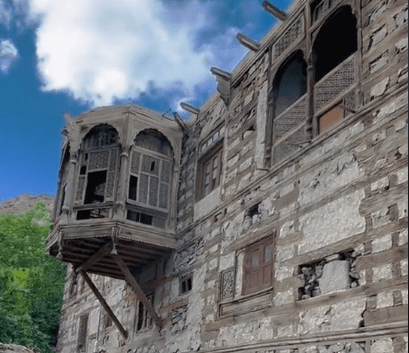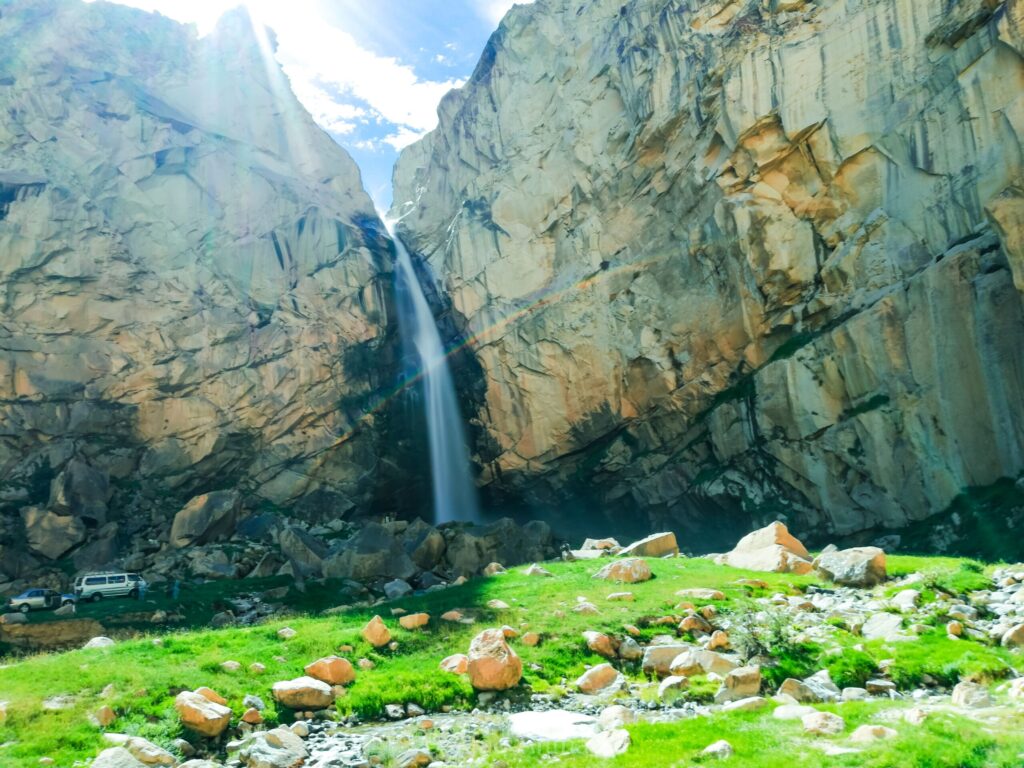Discover Kharmang Valley
The Land of Waterfalls and Lush Greenery

Climate & Weather
Pleasant summers and cool winters. Cooler than Skardu at around 12°C

Speciality
Greenery and Potential for future archaeological discoveries

Transport Routes
Accessible by road from Skardu (120 km distance). Nearest airport in Skardu.

Historical Places
2 historical place in kharmang Valley.

Tourist Points
5 amazing spots to visit in Kharmang Valley.

Hotel/Restaurant
12 Hotel/Restaurant in Kharmang Valley.

Facts & Figures'
Known as the "Valley of Forts" due to historical watchtowers and forts. Traditionally known for Balti culture and apricot production.

Geographical Location
Location: Northern Area of BaltistanAltitude= 3,000m to 5,000m above sea level
Area= Approximately 7,909 km²
Kharmang valley-Tourist places

Kharmang Fort
Kharmang Fort is an ancient monument located in the Kharmang district of Gilgit Baltistan. Also known as Boti Khar, this fort dates back to the 16th century and was constructed by the Kharpon rulers before 1565. It is a double-story structure that showcases the architectural style of the period. While Boti Khar still stands today, it needs renovation to preserve its historical significance. Another fort, Soma Khar, was built by Sher Shah of Baltistan before 1635, but it was damaged in 1948 and no longer exists. Kharmang Fort is privately owned and, unfortunately, is not protected under any legal heritage status. Visiting this fort offers a glimpse into the rich history of the region and the legacy of its rulers.

Manthoka Waterfall
Manthoka Waterfall is one of the most stunning natural attractions in the Skardu Valley, located in the village of Manthoka within the Kharmang Valley. This waterfall, which stands at a height of about 180 feet, is surrounded by lush green pastures, towering rocky mountains, and streams of crystal-clear water. Manthoka Waterfall is around 75 km from Skardu city and is easily accessible by road. The waterfall is not only a visual delight but also serves as a base camp for routes leading to other parts of the Kharmang subdivision. Visitors can enjoy fresh trout from the nearby fish farm, making it a perfect spot for nature lovers and food enthusiasts alike. The tranquil environment and the refreshing ambiance make Manthoka Waterfall a must-visit destination for anyone traveling to Kharmang Valley.

Khamosh Waterfall
Khamosh Waterfall, is a hidden gem in the Kharmang Valley of Gilgit-Baltistan. This waterfall is surrounded by vibrant flowers and lush green, near the main road. creating a serene environment that invites visitors to relax and enjoy nature. The waterfall is famous for its stunning views as water cascades over rocks, offering a bird’s-eye view of the Kharmang Valley. It is one of the highest overhung waterfalls in the Gilgit-Baltistan region, making it a natural wonder and special for those who looking for peace and tranquility. The sound of the water flowing down the rocks, combined with the surrounding natural beauty, creates a mesmerizing experience for visitors. Khamosh Valley is located approximately 115.7 km from Skardu City, a journey that takes around 3 hours and 10 minutes via the Kargil-Skardu Road.

Ghandus Lake
Ghandus Lake is a breathtaking high-altitude lake nestled in the heart of Kharmang Valley. Also known as Sheosar Lake, it sits at an elevation of approximately 4,142 meters (13,589 feet) above sea level. The journey to Ghandus Lake is an adventure in itself, as visitors traverse through rugged landscapes, narrow pathways, and lush green meadows. The lake is surrounded by snow-capped peaks, and its crystal-clear waters reflect the stunning beauty of the surrounding environment. The colors of the lake change throughout the day, offering a spectacular display of deep blues and vibrant turquoise. The lake holds cultural significance for the local communities, and visitors can immerse themselves in the rich traditions and customs of the Kharmang Valley.
Accommodation Options
Hotels:
Kharmang Valley offers a range of accommodation options for travelers, although the choices are not as extensive as in more popular tourist areas like Hunza. Small, family-run hotels are available, providing comfortable and affordable lodging with basic amenities. These hotels often have a cozy atmosphere and offer stunning views of the surrounding mountains and valleys.
Guesthouses:
For a more personalized experience, guesthouses in Kharmang Valley are a great choice. Many of these guesthouses are run by local families who provide warm hospitality and home-cooked meals. Staying in a guesthouse allows you to immerse yourself in the local culture and traditions while enjoying the comfort of a home-like environment.
Camping:
For the adventurous traveler, camping in Kharmang Valley is an unforgettable experience. There are several spots near Manthoka Waterfall, Khamosh Waterfall, and Ghandus Lake where you can pitch your tent and enjoy the pristine natural surroundings. Camping under the stars in the tranquil environment of Kharmang Valley is a perfect way to connect with nature.
Local Cuisine & Dining
Traditional Dishes:
Kharmang Valley offers a taste of the unique Balti cuisine, which is known for its simple yet flavorful dishes. Some traditional dishes include skew, a hearty stew made with meat and vegetables, and momo, steamed dumplings filled with meat or vegetables. The local bread, khurba, is a must-try, often served with butter or apricot jam.
Dining Options:
Dining options in Kharmang Valley are primarily centered around small local eateries and guesthouses. These establishments serve traditional Balti cuisine made with fresh, locally sourced ingredients. While there are no fancy restaurants, the simplicity and authenticity of the food make for a delightful dining experience.
Shopping & Souvenirs
Handicrafts:
Kharmang Valley is home to skilled artisans who create beautiful handicrafts, including handwoven rugs, traditional clothing, and intricately designed jewelry. These items make for unique souvenirs that reflect the rich cultural heritage of the region.
Local Products:
When visiting Kharmang Valley, be sure to purchase some locally produced goods, such as dried apricots, walnuts, and pure honey. These natural products are not only delicious but also make for thoughtful gifts to bring back home.
Travel Tips & Safety
Altitude:
Kharmang Valley is situated at a high altitude, so it’s important to acclimate properly to avoid altitude sickness. Take it slow during the first few days and stay hydrated to help your body adjust to the thinner air.
Weather:
The weather in Kharmang Valley can vary significantly depending on the season. Summers are pleasant and ideal for outdoor activities, while winters can be harsh with heavy snowfall. It’s advisable to check the weather forecast before your trip and pack accordingly.
Transportation:
Public transportation in Kharmang Valley is limited, so renting a private vehicle is the best option for exploring the area. The roads can be challenging, with steep inclines and sharp turns, so it’s recommended to hire a local driver who is familiar with the terrain.
Photography Spots
Manthoka Waterfall:
One of the most picturesque spots in Kharmang Valley, Manthoka Waterfall provides a perfect backdrop for stunning photographs. The 180-feet high waterfall, surrounded by lush greenery and rocky mountains, is a natural wonder that should not be missed.
Khamosh Waterfall:
For those seeking a more tranquil setting, Khamosh Waterfall is an ideal spot for photography. The serene environment and the cascading water create a soothing ambiance, making it a great place for capturing the beauty of nature.
Ghandus Lake:
Ghandus Lake, with its crystal-clear waters reflecting the surrounding snow-capped peaks, offers breathtaking photo opportunities. The changing colors of the lake throughout the day provide a magical setting for photographers.
How to Get To Kharmang Valley?
By Road Travel
The most common way to reach Kharmang Valley is by road. The journey from Skardu to Kharmang takes about 3 to 4 hours, depending on road conditions. The route offers stunning views of the Indus River and the surrounding mountains, making the drive an adventure in itself.
By Air Travel
The nearest airport is in Skardu, which is well-connected to major cities like Islamabad. From Skardu, you can hire a taxi or rent a vehicle to drive to Kharmang Valley. The scenic flight to Skardu is an experience in itself, offering aerial views of some of the highest peaks in the world.
A Traveller Guide to Kharmang-valley:
Activities in Kharmang Valley
Trekking:
Kharmang Valley offers several trekking routes for adventurers, ranging from easy walks to more challenging hikes. The trails lead through beautiful landscapes, including meadows, forests, and high-altitude lakes, providing an immersive experience in nature.
Cultural Tours:
Explore the rich cultural heritage of Kharmang Valley by visiting ancient forts, mosques, and traditional villages. Engage with the local community and learn about their customs, traditions, and way of life, which have been preserved for centuries.
Exploring Natural Wonders:
Kharmang Valley is home to some of the most stunning natural wonders, including waterfalls, lakes, and mountains. Spend your days exploring these breathtaking sites and experiencing the tranquility and beauty of the region.
Climate & Weather
Kharmang Valley experiences a diverse climate, with mild summers and cold winters. The best time to visit is from May to September when the weather is pleasant and ideal for outdoor activities. Winter months bring heavy snowfall, making the valley a winter wonderland but also more challenging to access.
Geographical Location
Kharmang Valley is located in the Gilgit-Baltistan region of northern Pakistan. It is situated in the southeastern part of Skardu district, bordered by Kargil in the east and Astore in the west. The valley is characterized by its rugged terrain, with the Indus River flowing through it, and is surrounded by towering mountain ranges.
Historical & Cultural Significance
Kharmang Valley has a rich historical and cultural heritage, with roots dating back to the ancient Tibetan and Balti civilizations. The valley was once part of the larger Baltistan region, which was influenced by Tibetan culture and Buddhism before the advent of Islam. The historic forts, mosques, and traditional architecture found in Kharmang Valley are a testament to its cultural significance.
Itineraries & Travel Guides
To make the most of your trip to Kharmang Valley, consider planning a detailed itinerary that includes visits to key attractions like Kharmang Fort, Manthoka Waterfall, Khamosh Waterfall, and Ghandus Lake. Allocate time for trekking, cultural tours, and photography to fully experience the beauty and heritage of the valley. Hiring a local guide can enhance your experience by providing insights into the history, culture, and natural wonders of Kharmang Valley.
